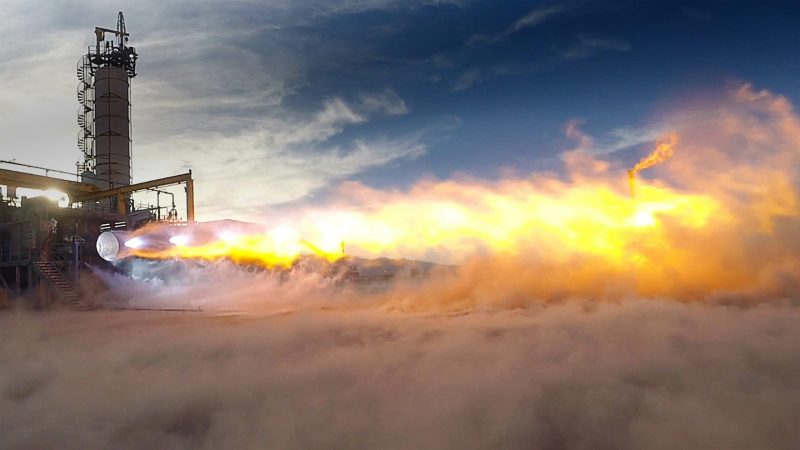

The Michigan State University Engine Research Laboratory is usually calm, but by midmorning on this August day, everyone is on edge. Then, a few minutes before noon, assistant engineering professor Norbert Müller gets the call they’re all waiting for: The most influential man in energy research is here to see Müller’s work.
The tall German shouts the news and trots down the cinderblock hallway toward the front door, drawing a wake of colleagues and graduate students. They flood the sidewalk, standing on tiptoe and squinting through the asphalt’s thermal shimmer as an SUV pulls up and a small group gets out. Finally, a tugboat of a man dressed in a blue sport jacket and print tie emerges, and tows his entourage across the parking lot toward the crowd.
Arun Majumdar approaches with restrained economy, as if he has calculated the caloric output of each stride. He steps onto the sidewalk and extends one hand just far enough to reach Müller’s, while the other hand stays pressed tightly at his side. “Good to see you,” he says. Müller, one of the world’s foremost experts in thermal-fluid engineering, shifts from foot to foot as he meets his guest. Until now, Müller has had to support his research with hard-won five- and six-figure grants from multiple sources. Majumdar gave him $2.5 million. In Müller’s world, Majumdar wields immense power. He has hundreds of millions of dollars to dole out to high-risk projects like the one that Müller is about to unveil. And he’s here to check up on his investment.
Majumdar, 47, directs the Advanced Research Projects Agency Energy, or Arpa-E, a new federal entity that’s placing multimillion-dollar bets on Müller and other corporate and university researchers who are looking for new ways to generate, amplify, and store energy. Most researchers struggle to make incremental progress on established lines of inquiry, and they mostly attract small grants and investment. But Arpa E grantees can afford to go after wild, ambitious notions. The results include bacteria that can make gasoline out of carbon dioxide, molten-silicon photovoltaic wafers, and airborne wind turbines.
Every few weeks, Majumdar makes the rounds of his grantees to check on their progress. It’s not supposed to be an inspection, but Müller is obviously nervous as he ushers Majumdar inside.
As a boy, Majumdar moved around India constantly. His father, a telecommunications specialist, serviced radio equipment at various airports. Inspired by the aircraft he watched landing and taking off, Majumdar began making wooden gliders and experimenting with his own model airplane designs. Coming out of secondary school, he took the entrance exam for the Indian Institutes of Technology and, among 150,000 applicants, landed one of 1,500 slots. Ultimately, he emerged as the top engineering student at IIT-Bombay. From there,he was offered a Regents fellowship at the University of California at Berkeley, where he studied the science of heat and radiation under thermal expert Chang-Lin Tien, who would go on to become the university’s chancellor.

“His philosophy was to work the extremes—either really small or really large,” Majumdar says of his mentor. “That’s where interesting science happens.” Majumdar eventually became a professor at Berkeley himself, focusing on nanotechnology, transportation and energy conversion. In his spare time, he began advising start-up companies and venture-capital firms in Silicon Valley. Then he joined Nobel Prize–winning physicist Steven Chu at Lawrence Berkeley National Laboratory as the associate laboratory director for energy and environment.
At the time, Chu was talking about the need for a green-energy incubation program, and in 2006 he proposed that the U.S. Department of Energy create a risk-tolerant agency to fund energy technologies that no private company would dare take a chance on. President Obama appointed Chu to head the DOE in 2008, and Arpa-E received its first $388 million budget from the $275 billion American Recovery and Reinvestment Act in early 2009.
Chu and Majumdar modeled their new agency on Darpa, the Defense Advanced Research Projects Agency. The U.S. government created Arpa, later renamed Darpa, after the Soviets launched Sputnik in 1957. The satellite beat the U.S. into space and spurred hysteria over our faltering technological lead. In addition to creating guided missiles and stealth technology, Darpa-funded research produced some of the most useful peacetime inventions in history, including cellphones, GPS and the Internet. “Now our generation is facing three Sputniks of our own,” Majumdar explains. “They are energy security, economic security and environmental security.”
With energy research starved for government funding since the end of the 1970s oil crisis, Arpa-E’s first call for short concept papers in 2009 initiated a tidal wave of proposals— over 3,700—that crashed the DOE computer system. They weren’t all cogent proposals. “About 27 percent didn’t satisfy the first or second laws of thermodynamics,” Majumdar says. Those that did were examined by a panel of hundreds of the nation’s top scientists, recruited by Chu. They winnowed them down to 300 finalists, who were invited to submit full proposals. In the end, 37 were selected for first-round grants averaging $4 million (applicants need to have secured commitments for matching funds from nonfederal sources). “Note that we didn’t break it up into $100,000 chunks so that we could give out 1,500 grants,” Majumdar says. “That’s not risktaking. We needed to award enough to make a substantial difference.”
Whereas Darpa has a built-in customer for its creations — the Department of Defense — Arpa-E’s creations must survive in the open market. And the grants have tempted some private capital off the sidelines. Venture capitalists and other investors, drawn by the profit potential of technology that had been peer-reviewed and vetted by the country’s top scientists, invested some $33 million in Arpa-E grant winners in the two months following the first award announcements.
After the wide-open first round, the second round focused on next-generation batteries, carbon capture and alternative fuels. A third round concentrated on grid-scale electricity storage, electronics for photovoltaics, and novel approaches to HVAC. Future areas of interest might include thermal storage, power electronics, improvements to photosynthesis efficiency, and new approaches to the extraction of rareearth elements.
As is the case with Darpa, a large proportion of Arpa-E’s pie- in-the-sky energy ideas won’t make it out of the lab. “But if just a few of them pay off,” says Donald Sadoway of the Massachussetts Institute of Technology, an Arpa-E grantee who is designing a liquid-metal battery, “the impact is enormous.” With the right energy breakthroughs, he suggests, the program could lead to a national-security victory over the nation’s dependence on oil. At the very least, it could turn sources like solar and wind power into viable parts of our energy portfolio.

Two years into the program, some of Majumdar’s Arpa-E investments are paying off. Müller’s creation, known as a Wave Disk Engine, is a cross between a diesel and a turbine that incorporates a shock wave to compress the fuel and transmit its energy. Today Majumdar will see the first working prototype.
Majumdar says Müller is in many ways typical of Arpa-E grantees, or “performers” in Arpa-E’s evolving lingo. “Here’s a guy with a very good, very important idea who has bee working for years with hardly any support. We’ve lost the art of making new kinds of engines in this country. If we’re going to bring back that sort of innovation, we need to encourage people like him to take chances. That’s how you put a man on the moon.”
Müller leads Majumdar and his team to his lab, where a circular device the size of a cooking pot rests on a bench. In his grant application, Müller said the Wave Disk would be lighter, cheaper and five times as efficient as conventional automotive engines, and could give a hybrid car a 500-plus mile driving range. If those claims seem a little ambitious, that’s the point. “If we’re going to invent our way out of this crisis,” Majumdar tells me, “we’ve got to swing for the fences. We have to find a way to squeeze 100 years of innovation into the next 20 years.”
On seeing the machine, connected to an array of sensors and feeder tubes, Majumdar brightens. Evidently unconcerned with getting grease on his coat, he crouches and fiddles with the device. Then, still on his haunches, he begins to pummel Müller with questions. “Is balancing an issue? Is leakage a problem? What is the optimal speed? Doesn’t the shock wave produce entropy?”
It’s an onslaught. “To understand the role of the shock wave, imagine a bomb,” Müller says, stammering slightly. “Well, maybe that example’s not so good.” He pauses. “Imagine a bumblebee. It’s too heavy to fly normally with those little wings, so it creates pressure waves that travel with sonic speed, compressing the air to boost lift. Inside the wave disk, we use a shock wave to compress the fuel and utilize it to convert energy into work.”
Satisfied, Majumdar nods and fires off another question, then another. Later he will tell me that he has integrated “constructive confrontation,” a concept he borrowed from former Intel CEO Andy Grove, into the culture of Arpa-E. “When we’re talking science and engineering and evaluating new programs and proposals, I’m no longer the director,” Majumdar says. “We debate things out as equals, and the good, strong ideas are the ones that survive. That’s the way science works best.”
Müller slowly senses that Majumdar is trying to improve his work, not disparage it. He takes the questions point by point, his nervousness evaporating. We move behind a window of protective glass and, on Müller’s cue, a grad student at a computer terminal energizes an electric motor to start the engine’s internal blades spinning. As the tachometer moves past 1,000 rpm, then 1,500, the student glances at Müller.
“Let’s not start combustion just yet,” Müller says. “Wait until the speed stabilizes.” He glances toward Majumdar, then back at the screen, as the tach creeps toward 2,000 rpm. Finally, he nods at the student: “OK, let’s see if Frankenstein comes to life.” As we watch from behind the glass, the grad student feeds fuel and ignition to the engine. The wave disk begins to shake, then sputters to life. As it hums away on the table, a smile creeps across Majumdar’s face. “It’s got a heartbeat,” he says.
Majumdar begins to relax. His technical questions keep coming, but they’re like those of a proud dad. He chats up the grad students—”Do you have an energy club on campus yet?”—and talks to Müller about his prospects for private funding. Then everyone heads for a nearby meeting room. As Majumdar tucks into a box lunch, another MSU professor updates him on an Arpa-E-funded bioreactor. The joint project with MIT deploys hydrogen-eating bacteria to convert carbon dioxide into liquid transportation fuels. Majumdar seems to require no catch-up on the project. He nods and asks questions, he shakes hands with everyone, and then it’s time to leave. He has another visit to make nearby.

A quiet, government-funded grant program has created technical revolution before. Consider the history of the Internet. In 1963, Arpa gave a group of MIT researchers $2.6 million to develop a computer time-sharing system. That early work eventually evolved into Arpanet, the first wide-area packet switching network, which, in turn, became the Internet. More than 30 years later, that $2.6-million investment has led to an Internet economy worth at least $250 billion in the U.S., according to the Organization for Economic Cooperation and Development. Advertising-supported online businesses alone employ 1.2 million Americans, according to a 2010 study funded by the Interactive Advertising Bureau.
Dozens of countries are now vying to dominate the clean-energy market, expected to be worth $2.2 trillion by 2020, and the U.S. needs to do something radical to compete. This country spends about $4 billion in public-energy research and development (not counting Recovery Act spending), compared with Japan’s $3.1 billion and Europe’s $3.3 billion. But that number is misleading. The U.S. ranks far lower when national commitment to energy R&D is measured as a percentage of GDP. Japan, Korea, France and China all spend a higher fraction of their GDP on energy research than the U.S. And China, which last year became the world’s biggest overall investor in energy-efficient technology, plans to sink an average of nearly $74 billion a year into energy R&D over the next decade in a bid to become the world’s biggest developer and manufacturer of clean-energy technology.
Arpa-E’s influence will be measured in terms of barrels of oil saved, tons of CO2 kept out of the atmosphere, percentage increases in solar efficiency, and boosts in the energy density of batteries. And because Arpa-E money is seed money, intended to get a prototype built that will entice follow-on funding from the private sector, projects will often need a decade to shake out as successes or failures.
Majumdar is on what seems to be a typical phone call as we drive. “Uh-huh,” he says into the phone. “If they claim they can reduce the cost of PVs [photovoltaics] by half, have they provided the calculations? If not, they need to get them to us, and let’s have a look.” He closes his phone and turns toward me. “Right now, solar photovoltaics cost $8 to $10 per watt, installed,” he says. “We can get that down to a dollar in 10 years with business as usual. But if we get there in five years, America’s ahead of the game.”
Majumdar’s second stop today is the General Motors Research Lab in the Detroit suburb of Warren. Arpa-E dollars have found their way to university researchers and start-up companies, but it turns out there are researchers at major companies, such as GM, whose most creative ideas don’t get much corporate backing. “Big companies are often technically sound but not super innovative,” says Majumdar as we pull into the campus.
The Research Lab, where 16,000 GM engineers, designers and technicians work, has housed the company’s most audacious engineering efforts for more than 50 y ears. We meet Alan Browne and Jan Aase in the lobby of the R&D building. Aase directs GM’s Vehicle Development Research Laboratory, and Browne is leading the development of the company’s Lightweight Thermal Energy Recovery (LighTER) system. About 60 percent of a fuel’s energy goes into the water jacket or out of the tailpipe, Browne and Aase explain. Their research aims to harvest energy from low-grade waste heat.
The LighTER system uses a stretched wire made of what’s called a shape metal alloy—a blend of nickel and titanium— that shrinks when heated and expands when cooled. “In a hybrid system, a loop of this wire could be used to drive an electric generator to charge a battery,” says Browne as we walk to the lab. “In a conventional engine, it could even replace the alternator, without any load on the engine.”
The contraption at the end of the table, a neat mass of coiled wire and sprockets, looks like some kind of perpetual motion machine. Browne passes out safety glasses and fires up a heat gun to simulate the temperature inside a typical exhaust pipe. Just like that, the machine starts to move, pulling itself through the large pulleys as the cables shrink and expand. I reach out and try to stop one of the axles with my hand, but I can’t—it’s too powerful.
“We’ve exceeded the highest reported power output for any thermal-harvesting device,” Browne says to Majumdar proudly. “But the big challenge is the cooling side. I know you have a background in heat transfer, so if you have any ideas on the flight home about how to cool it quickly…” It’s the sort of thing a grantee might say to flatter his benefactor before saying goodbye, but Majumdar springs from his chair and heads for the chalkboard. “I’m thinking you want to introduce some turbulence!” he says. Grabbing a hunk of chalk, Majumdar fires off questions—How can we maximize thermal transfer? What wire shape would shed heat fastest? What about the shape of the box?—scribbling, theorizing. Within minutes, he’s debating
various options with Browne and his team.
The younger engineers, who were ready to file out of the room a moment ago, stop to watch, transfixed by the performance. Majumdar and Browne trade riffs and what-ifs, brainstorming until Majumdar has filled nearly every inch of the chalkboard with calculations. “Wow,” one engineer says to another, shaking his head. “It’s not every day you see something like this.”
Wiping chalk dust from his hands, Majumdar heads for the parking lot to begin his journey back to Washington. But the GM guys have one more thing to show him: their new hydrogen test vehicle. It’s been a long day, but he gets behind the wheel. Majumdar is obviously delighted to have a tangible prototype at his command. He steers the car around one end of the Tech Center’s artificial lake to a straightaway, then stomps on the throttle and careens away.















